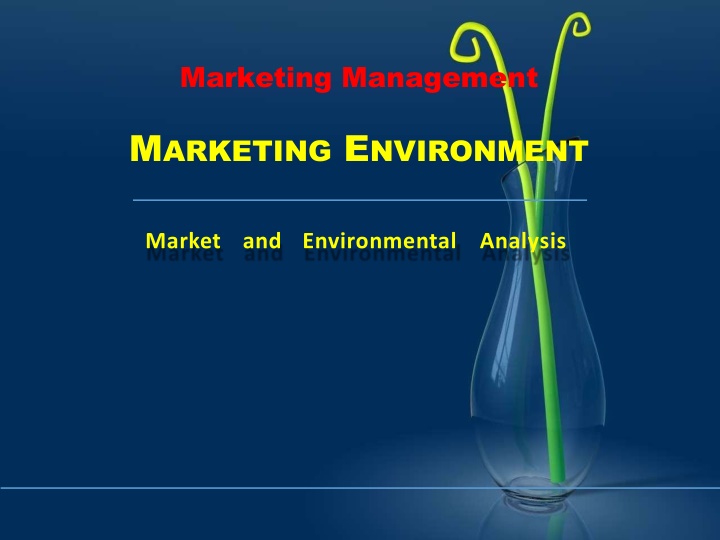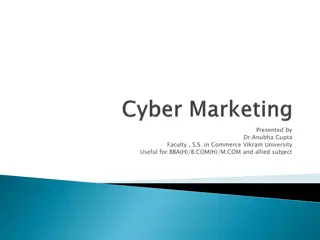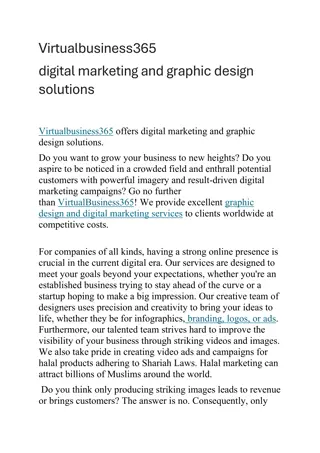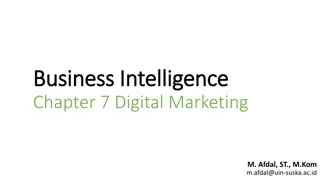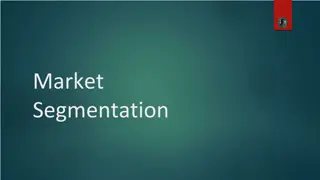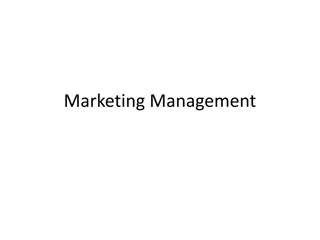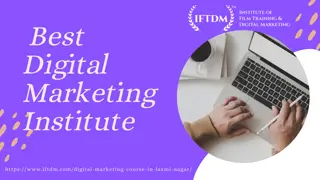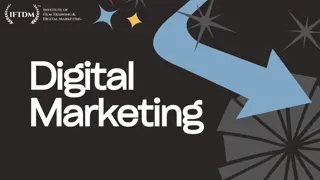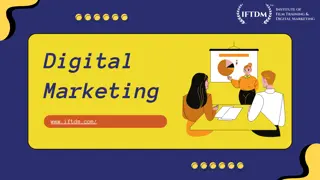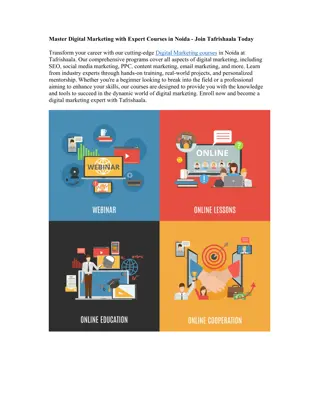MARKETING ENVIRONMENT
The marketing environment comprises external factors impacting an organization's relationship with customers. It includes macro-environment (legal, technological, sociocultural), micro-environment (demographic, economic, natural, technological, political, cultural forces), and internal environment. Analyzing these environments helps in strategic decision-making and managing change effectively.
Download Presentation

Please find below an Image/Link to download the presentation.
The content on the website is provided AS IS for your information and personal use only. It may not be sold, licensed, or shared on other websites without obtaining consent from the author.If you encounter any issues during the download, it is possible that the publisher has removed the file from their server.
You are allowed to download the files provided on this website for personal or commercial use, subject to the condition that they are used lawfully. All files are the property of their respective owners.
The content on the website is provided AS IS for your information and personal use only. It may not be sold, licensed, or shared on other websites without obtaining consent from the author.
E N D
Presentation Transcript
Marketing Management MARKETING ENVIRONMENT Market and Environmental Analysis
Introduction The marketing environment consists of external factors and forces that directly and/or indirectly impact the organization to develop and maintain successful relationships with its target customers. There are two perspectives (sometimes three) namely: 1. the macro-environment, 2. the micro-environment, 3. the internal environment. The external legal/regulatory, technological, and sociocultural that can exert considerable direct and indirect pressures on both domestic and international marketing activities. external environment, factors competitive, which includes economic, all political, the p.03
Introduction: Marketing Environment consists of the forces close to the company that affect its ability to serve its customers, e.g., the company, suppliers, marketing channel firms, customer markets, competitors and publics. Micro- environment consists of the large societal forces that affect the micro-environment: Demographic environment, Economic environment, Natural environment, Technological environment, Political environment, and Cultural forces. Macro- environment p.04
Marketing Environment Demography Cultural & Social Customers Suppliers Economic factor The Distributors Organizati on Company s Internal Environment Natural force Competitors Supply chain Technological change Political issue Fig: Marketing Environment including micro, macro and internal environment p.05
Introduction: Marketing Environment All factors that are internal to the organization are known as the 'internal environment'. Internal environment They are generally audited by applying the 'Five Ms' which are Men, Money, Machinery, Materials and Markets. The internal environment is as important for managing change as the external. The internal environment can be audited using other approaches such as SWOT Analysis, Michael Porter's Five Forces Analysis or PEST Analysis. p.06
Marketing Environment With regard to the question of how the organization monitors the environment, there are two types of environments are: 1. Dynamic environment 2. Complex environment In a dynamic environment, organization is typically faced with major change in the areas of technology and markets, with the result that decisions can no longer be based upon the assumption, rather than that of scientific basis. The focus needs to be upon the future with a far greater degree of inspirational interpretation. Idea of futures can then be used to identify the likely impact upon consumers, suppliers, competitors, government, the financial institutions, their probable responses. alternative For organizations faced with a complex environment, many of the issues and problems to which reference has been made are exacerbated p.07
Questions in Environment Based Marketing Marketing analysis is based upon the answers to six questions: 1. How complex is the environment? (Complexity is a measurement of the number of different environmental forces which have an impact, or potential impact) 2. How routine and standardized are orgn interactions with elements of the environment? 3. How interconnected and how remote, initially, are the significant environmental variables? 4. How dynamic and how unpredictable are the changes taking place around the organization? 5. How receptive is mgt to the ways in which environmental pressures adversely affect input and output processes? 6. How is flexibility of choice and to what extent is the orgn constrained from moving into new areas? p.08
Micro Environment The micro-environment is made up of those elements that are closest to the company and that exert the greatest and most direct influence over its ability to deal with its markets. The micro-environment includes: the organization itself, other company departments, suppliers, marketing intermediates, customers, competitors, and various publics, which make up the company s market. Marketing management s job is to attract and build relationships with customers by creating value and satisfaction. p.09
Micro Environment: The Company In designing marketing plans, marketing management takes other company groups into account groups such as: Top management, Finance, Research and development (R&D), Purchasing, Manufacturing, and Accounting. All those interrelated groups form the internal environment. Top management, Finance, Research and development, Purchasing, Manufacturing, and Accounting. p.9
Micro Environment: The Company The responsibilities of all departments: Top management sets the company s mission, objectives, broad strategies and policies. Marketing plans must be approved by top management before be implemented. Finance is concerned with finding and using funds to carry out the marketing plan. Research and development (R&D) department focuses on designing safe and attractive products; Purchasing worries about getting suppliers and materials, Manufacturing is responsible for producing the desired quality and quantity of products. Account measures revenues and costs to help marketing. p.10
Micro Environment: Suppliers Suppliers company therefore, they are linked in the company s overall customer value delivery system. provide to the resources its goods needed and by the provide services, Suppliers sometimes are treated as partners to provide customer value Marketing managers must watch supply availability, supply shortage or delays, labor strikes, and other events Marketers must watch supply availability and pricing Effective partnership relationship management with suppliers is essential p.11
Micro Environment: Marketing Intermediates Marketing intermediates help the company to: promote, sell, and distribute its goods to final buyers. They include: resellers, physical distribution firms, marketing services agencies, and financial intermediates. Resellers are distribution channel firms that help company find consumers or make sales to them. These include: wholesalers, and retailers. Physical distribution firms help the company to stock and move goods from their profits of origin to their destinations. p.12
Micro Environment: Customers Consumer markets consist of individuals and households that buy goods and services for personal consumption; Business markets further processing or for use in their production buy goods and services for process; Reseller markets buy goods and services to resell at a profit; Resell er Marke t Busine ss Marke t Govt. markets are made up of govt agencies that buy goods & services to produce public services or goods and services to other; Governm ent Market transfer the International markets consist of buyers in other countries, plus consumers, resellers and governments. Internatio nal Market Consum er Market Fig. Different types of consumers producers, p.14
Micro Environment: Competitors A company must provide greater satisfaction than competitors do. customer value and Marketers must: do more than simply adapt to the needs of target consumers, also must gain strategic advantage by positioning their offerings strongly offerings in the minds of consumers. provide better customer competitors do. consider its own compared to those of its competitors. against competitor s satisfaction than size and industry position No single marketing strategy is best for all companies. p.14
Micro Environment: Competitors Three types of competitors are: Brand Competitors customers at similar prices, e.g., pharmaceutical products - Market similar products to same Category Competitors - Market different products that solve same problem or satisfy same basic customer need, e.g., stationary products, software service etc Total Budget disposable income of the customer Competitors - Other competitors for the Benefit Provided: Brand Competitors Category Competitors Generic Competitors Self Study p.15
Micro Environment: Publics A public is any group that has an actual or potential interest in or impact on an organization s ability to achieve its objectives. There are seven types of publics: Financial publics influence Medi a publi c Financi al public the obtain investment stockholders financial publics. company s ability to funds. houses, are Banks, and major the Citizen action public Governm ent public Loca l publi c Media publics carry news, features, and option. Newspapers, magazines, and radio-television stations are included in this group. Gener al publi c Fig: Different types of publics Intern al publi c editorial p.16
Micro Environment: Publics Government publics take government developments into account. Marketers often consult company s lawyers on issues of product safety, advertising truth & other matters. Citizen action public - company s marketing decisions may be questioned by consumer organizations, environmental groups, minority groups and others. Local community organizations. Large company usually appoints a community relations officer to deal with the community, attend meetings and contribute to worthwhile causes. publics, include neighborhood residents and General public - company needs to be concerned about the general public s attitude toward its products and activities. Internal public, includes workers, managers, volunteers, and board of directors. When employees feel good about their company, this positive attitude spills over to external publics. p.17
Macro Environment The company and all of the other actors operate in a larger macro-environment opportunities and pose threats to the company. of forces that shape Six major forces in the company s macro-environment are: 1. Demographicenvironmental, DE 2. Economicforces, 3. Natural issues, EF CF 4. Technological issue, Macro Environment 5. Political forces, and PF NI 6. Cultural forces. TI p.19
Macro Environment: Demography Demography is the study of human populations in terms of size, density, location, age, gender, race, occupation and other statistics. Demographic marketers because it involves people, and people make up markets. environment is of major interest to The world population is growing at an explosive rate. It now totals more than 6 billion and will exceed 7.9 billion by the year 2025. A growing population means growing human needs to satisfy. Exam: People in SSWD (single, separated, widowed, divorced) group need smaller apartments, & food packed in smaller size. p.19
Macro Environment: Demography Two main factors involved are: 1. Migration, and 2. Diversity Migration: People developed comparatively region. are frequently migrating from less region much (less developed comfortable) (comfortable) to In Bangladesh, most poor people tend to shift in Dhaka city for a work. Exam: garments industry offers work for women and children. Men are engaged in different works, at least Reason: The they pull rickshaw, pull non-powered cars etc. p.20
Macro Environment: Demography Americans are a mobile people with about 12 million US households (more than one out of every ten) moving each year. Such population are of interest to marketers because people in different regions buy differently. Please see two countries. Japan, where almost everyone is Japanese. Diversity: The united States, with people from virtually all nations. USA has often been called a melting pot in which diverse groups from any nations and cultures have melted into a single, more homogeneous whole, seems to become a Salad Bowl. p.21
Macro Environment: Demography Exam: The US population is: White, African Americans Hispanic 72 percent 13 percent 11 percent 3 percent 1 percent Asian native (Eskimos and Aleuts) The US-Asian population also has grown rapidly in recent years and now totals about 3 percent of the population. During the next half century, the proportions of both Hispanic and Asians will more than double. Such population shifts interest marketers because people in different regions buy differently. Also Americans have been moving from rural to metropolitan areas continuously. p.22
Macro Environment: Demography Therefore, more people are: Divorcing or separating Choosing not to marry Choosing to marry later Marrying without intending to have children Increased number of working women Stay-at-home dads Bangladesh Issue: Living in: Rural 72%, Urban 21%, Semi-urban 7% People: about 57% of population is below 25 years of age Birth rate: High population growth rate- 1.57% Religion: mostly Muslim, with about 10% from other religions Literacy: 47.9%, 15+ year old literacy rate increased 12% in 10 yrs. Family: Trend of nuclear families in urban areas. Population density: highest population density in the world Facilities: most public facilities are in urban area, i.e., internet. p.23
Macro Environment: Demography People make up the market, the basis for any market: Pre- and early adolescents, age upto 12 View TV ads as just advertising Baby & Tweens Teens Spend approximately 72 hours per week tuned in electronically View shopping as a social sport Adapting online shopping Born between 1979 and later Surpassed population of baby boomers in 2010 Two Stages: 1) Just passed teenage, 2) On careers and started families. Gen Y found to be: inquisitive, quick shoppers, opinionated, diverse, multi-taskers, good time managers, environmentally aware. Independent, tough, adaptable, cautious, and skeptical Max buying capability, home owner, ought to goal Avid buyers of the latest technology and recreation Generation Y Born between 1965 and 1978 Generation X p.25
Macro Environment: Economic Economic environment consists of factors that affect consumer purchasing power and spending patterns. Marketers economy in the short and long-terms. need to consider the state of a trading Some consume most of their agricultural and industrial output e.g. India. These countries opportunities. countries have subsistence economics they offer few market Marketers must pay close attention to major trends and consumer spending patterns both across & their markets. Industrial economies are richer markets p.25
Macro Environment: Economic The marketers should have to look at: Interest rates, The level of inflation employment level per capita, Long-term prospects for the economy GDP per capita. Also on: Changes in income Value ways marketing, to offer involves financially careful buyers greater value - right combination of quality and service at a fair price p.26
Macro Environment: Economic Economic situation changes in consumer spending patterns Ernst Engel: Engel s law As income rises: The percentage spent on food declines The percentage spent on housing remains constant The percentage spent on savings increases Bangladesh Issue: GDP 6.7% Inflation ~10% Exchange Rate BDT 82 per USD Steady economic performance despite global slowdown. p.27
Macro Environment: Natural Natural environment involves the natural resources that are needed as inputs by marketers or that are affected by marketing activities. Marketing trends: Shortages of raw materials Increased pollution Increase government intervention Environmentally sustainable strategies Marketing Issues: 1. First issue involves growing shortage of raw materials. Air and water seem to be infinite resources, but some non- renewable resources, such as oil, coal etc. are limited. p.28
Macro Environment: Natural 2. The second issue is increasing pollution. Industry will almost always damage environment. Consider the disposal nuclear wastes, the dangerous mercury level in the ocean, etc. the quality of the natural and of chemical 3. A third issue is increased governmental intervention in natural resource management. different countries vary in their concern and efforts to promote a clean environment. Example: In Germany, government vigorously pursue Otherwise, many poor nations, like Bangladesh, do little about pollution. The governments of environmental quality. 4. Environmentally sustainable strategies p.29
Macro Environment: Natural Example: Arong, garment selling division; Kumudini, as like as Arong - eliminated carton and smaller, napkins. a famous show-piece and ready-made polystyrene shopping recyclable and polyethylene and now wrappings bags paper uses and Bata, a worldwide shoe manufacturing company uses such type of polyethylene bags. cartons in place of McDonald s eliminated polystyrene cartons and now uses smaller, recyclable, paper wrapping and napkins biodegradable p.30
Macro Environment: Technology Technological dramatic creating new product and market opportunities. environment is perhaps the most forces that create new technologies, Examples: New antibiotics (saving lives), Organ transplants (Enhancing lives), Notebook computers (making easy life), Cell phone & Internet (easy communication). Marketing stimulating innovation are: Build scenarios Enlist the Web Talk to early adopters Use marketing research Create an innovative environment Cater to entrepreneurs p.31
Macro Environment: Technology The technological environment changes rapidly. Example: did not know about automobiles, air phones, radios, or the electric light. Abraham Lincoln did not know about television, aerosol cans, automatic dishwashers, conditioners, antibiotics or computers. Woodrow Wilson room air- Franklin D. Roosevelt did not know about Xerography, synthetic detergents, tape recorders, birth control pills, or earth satellites. John F . Kennedy did not know about personal computers, CD players, VCRs, or the World Wide Web. Barak Obama ?? every new technology technology; old industries are fighting to survive, adapting new technologies . replaces an older p.32
Macro Environment: Political Marketing decisions are strongly affected by developments in the political environments, that consists of laws, government agencies and pressure groups that influence and limit various organizations and individuals in a given society. The political arena has a huge influence upon the regulation of businesses, and the spending power of consumers and other businesses. Therefore, considering issues: Stability in the political environment; Government policy and laws on rules & regulations, tax; Government's position on marketing ethics; Government's policy on the total economy; Government s view on culture and religion; Trading agreements between governments such as EU, SAFTA, NAFTA, ASEAN, or others? p.33
Macro Environment: Political Political and legal environment of marketing: Laws and regulations on technology New technology Society Businesses Consumers State or regional laws Legislation affects marketing varies state by state Oregon: limits utility advertising to 0.5 percent of net income. California: bans fats in restaurants and bakeries. Regulatory agencies Consumer product safety commission Federal trade commission Food & Drug administration p.34
Macro Environment: Culture The cultural environment is made up of institutions and other forces that affect a society s preferences and behaviors. basic values, perceptions, The major cultural values of a society are expressed: people s view of themselves and others, views of organizations, society, nature, and the universe. Some people seek personal pleasure, wanting fun, change, and escape. Other seek self-realization through religion, recreation, or the avoid pursuit of careers of other life goals. Example: International Lux soap has four colorful and natural contaminations p.35
Evaluation of Environmental Analysis SWOT analysis: SWOT analysis is a tool for auditing an organization and its environment. It is the first stage of planning and helps marketers to focus on key issues. SWOT stands for strengths, weaknesses, opportunities, and threats. Strengths and weaknesses are internal factors. Once marketing objectives. key issues have been identified, they feed into It can be used in conjunction with other tools for audit and analysis, such as PEST analysis and Porter's Five-Forces analysis. It is a very popular tool with marketing students because it is quick and easy to learn. p.37
Environmental Analysis: SWOT SWOT analysis: A strength could be: Your specialist marketing expertise, A new, innovative product or service, Location of business, Quality processes and procedures, Any other aspect of business that adds value to product or service. A weakness could be: Lack of marketing expertise, Undifferentiated relation to competitors), Location of business, Poor quality goods or services, Damaged reputation. products or services (i.e. in p.38
Environmental Analysis: SWOT SWOT analysis: An opportunity could be: A developing market such as the internet, Mergers, joint ventures or strategic alliances, Moving improved profits, A new international market, A market vacated by an ineffective competitor. into new market segments that offer A threat could be: A new competitor in home market, Price wars with competitors, Competitor has a new, innovative product or service, Competitors have superior access to channels of distribution, Taxation is introduced on product or service. Opportunities and threats are external factors. p.39
Environmental Analysis: PEST PEST analysis: Org's marketing environment is made up from: Political 1. The internal environment e.g. staff (or internal customers), office technology, wages and finance, etc. 2. The micro-environment e.g. our external customers, agents and distributors, suppliers, our competitors, etc. 3. The macro-environment e.g. Political (and legal) forces, Economic forces, Socio-cultural forces, and Technological forces. Interest rates, The level of inflation employment level per capita, Long-term prospects for the economy Gross Domestic Product (GDP) per capita, and so on. Economic Socio- cultural Technologi These are known as PEST factors. cal The economic factor holds the followings- Recappi ng slide 27 p.39
Environmental Analysis: PEST Political Environment: The political environment answers the following questions- How stable is the political environment? Will government policy influence laws that regulate or tax on business? What is the government's position on marketing ethics? What is the government's policy on the economy? Does the government have a view on culture and religion? Is the government involved in trading agreements such as EU, NAFTA, ASEAN, or others? p.40
Environmental Analysis: PEST Socio-Cultural Environment: Social and cultural env. influences on business vary from country to country. Factors include: What is the dominant religion? What are attitudes to foreign products and services? Does language impact upon the diffusion of products onto markets? How much time do consumers have for leisure? What are the roles of men and women within society? How long are the population living? Are the older generations wealthy? Does the population have a strong/weak opinion on green issues? p.41
Environmental Analysis: PEST Technological Environment: Technology is vital for competitive advantage, and is a major driver of globalization. Consider the following points: Does technology allow for products and services to be made more cheaply and to a better standard of quality? Do technologies offer consumers and businesses more innovative products and services such as internet banking, new generation mobile telephones, etc.? How is distribution changed by new technologies e.g. books via the Internet, flight tickets, auctions, etc? Does technology offer companies a new way to communicate with consumers e.g. banners, customer relationship management (CRM), etc.? p.43
Evaluation of Environmental Analysis Michael Porter's Five Forces Analysis Five forces analysis, is similar to other tools for environmental audit, such as PEST analysis, but tends to focus on the single, stand alone, business or SBU (Strategic Business Unit) rather than a single product or range of products. Threat of entry Five areas namely the 1. Threat of entry, 2. The power of buyers, 3. The power of suppliers, 4. The threat of substitutes, 5. Competitive rivalry. forces looks at five key Power of supplie rs Power of buyer s Competiti ve rivalry Threat of substitut es p.43
Environmental Analysis: Five Forces The threat of entry. Benefits associated with bulk purchasing in economies scale. High or low cost of entry e.g. how much will it cost for latest technology? Ease of access to distribution channels e.g. do competitors have the distribution channels hemmed up? Cost advantages e.g. personal contacts or knowledge that larger companies do - will competitors retaliate? Government action e.g. will new laws are introduced that will weaken our competitive position? How important is differentiation e.g. champagne brands. The power of buyers There is a few, large players in a market e.g. large grocery chains. There are a large number suppliers e.g. small farming businesses supplying the large of undifferentiated, small p.44
Environmental Analysis: Five Forces The power of suppliers Power of suppliers tends to be a reversal of power of buyers. Where the switching costs are high e.g. switching from one software supplier to another. Power is high where brand is powerful e.g. Microsoft, Pizza Hut. Possibility of supplier integrating forward. Customers are fragmented (not in clusters) so that they have little bargaining power e.g. Gas/Petrol stations in remote places. Threat of substitutes Where there is product-for-product substitution e.g. email for fax, where there is substitution, better toothpaste reduces the need for dentists. Where there is generic substitution, e.g., CD, DVD and flash drive. Could always do without e.g. cigarettes. p.45
Evaluation of Environmental Analysis Diffenbach has identified three distinct stages in the evolution of corporate environmental analysis: 1. Appreciation stage, starts from emergence of books and articles that argue the looking beyond the short term and for considering wider implications of economic, social and political, technological factors that make up business envt. 2. Analysis stage, involves finding reliable sources of data, compiling and examining data, develop and discuss trends, developments and key relationships. 3. Application stage, very real attempts are made to monitor the environment, assess the implications for change and incorporate staff evaluations into strategy and plans. p.46
Evaluation of Environmental Analysis Three approaches to scanning (withthesebeingcharacterized by an increasing degree of structure, systemization, sophistication and resource intensity): Irregular systems, predominate with a poorly developed planning culture and focusing environmentally generated crises. The net effect is thatis simply placed finding solutions to short-term problems, with little attention paid to identifying and assessing the impact. responding upon to Periodic models, represent a general development of the irregular system and are intensive and sophisticated. The environment is reviewed regularly and a longer-term perspective is developed. more systematic, resource Continuous models, represent a further development and involve focusing upon business envt generally and upon the long term as opposed to short-term and specific issues. p.47
Evaluation of Environmental Analysis Continuous env. analysis is based on 3 basic premises: 1. The determinants of business environment; 2. The firm s response to environmental change therefore represents a fundamental strategic choice; 3. A knowledge of the business environment must precede the acquisition of any degree of control over it. success are dictated by the The barriers associated with continuous env analysis are: Poorlystructured Opinionbased Ambiguous in its definitions Available only on an irregularbasis Often provided by unofficial sources Qualitative in nature Poorlyquantified Likely tochange. Based on an insecure methodology p.48
